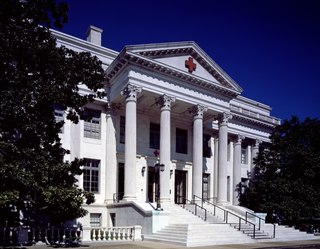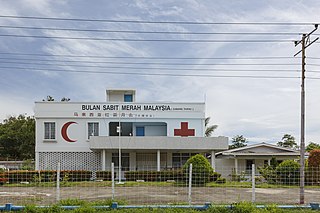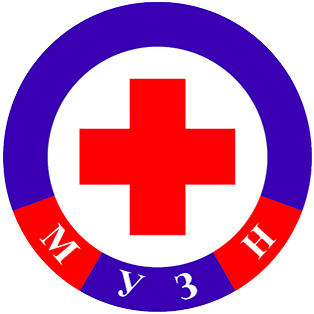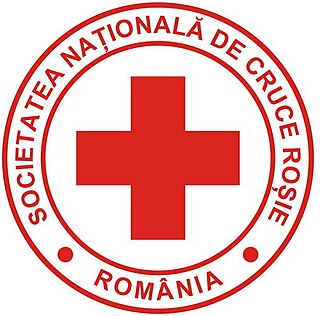The Cyprus Red Cross Society is the only Red Cross society in Cyprus recognised by the International Red Cross and Red Crescent Movement. The Headquarters of the Society are located in Nicosia.

The Turkish Red Crescent is the Turkish affiliate of the International Red Crescent and the first worldwide adopter of the crescent symbol for humanitarian aid.

The American National Red Cross, is a nonprofit humanitarian organization that provides emergency assistance, disaster relief, and disaster preparedness education in the United States. It is the designated US affiliate of the International Federation of Red Cross and Red Crescent Societies and the United States movement to the International Red Cross and Red Crescent Movement.

The Malaysian Red Crescent (MRC) is a voluntary humanitarian organization that seeks to promote humanitarian values, as well as provide service and public education in disaster management, as well as healthcare in the community. It is part of the International Red Cross and Red Crescent Movement.

The International Federation of Red Cross and Red Crescent Societies (IFRC) is a worldwide humanitarian aid organization that reaches 160 million people each year through its 191 member National Societies. It acts before, during and after disasters and health emergencies to meet the needs and improve the lives of vulnerable people. It does so independently and with impartiality as to nationality, race, gender, religious beliefs, class and political opinions.

The Zambia Red Cross Society was established in 1966 by an act of the Zambian Parliament. It had earlier started out as a branch of the British Red Cross. It has its headquarters in Lusaka.

Uganda Red Cross Society (URCS) is a humanitarian aid and community services charity in Uganda. It is a national member of the International Red Cross and Red Crescent Movement who draws mandates from the Geneva Conventions.

Severe Tropical Cyclone Ivy was a tropical cyclone that affected about 25% of the population of Vanuatu in February 2004. It was first classified as a tropical disturbance on February 21 between Vanuatu and Fiji. The system tracked northwestward, gradually organizing and intensifying. After attaining tropical storm status on February 23, Ivy strengthened more quickly as it turned southwestward toward Vanuatu. It attained peak winds of 165 km/h (103 mph) while moving over Vanuatu, making it an intense Category 4 cyclone on the Australian Region Tropical Cyclone Intensity Scale. By the time it passed through Vanuatu, Ivy had turned southeastward, and it gradually weakened while accelerating. After becoming extratropical on February 28, it passed just east of New Zealand and eventually dissipated on March 2.

Pakistan Red Crescent Society, is a humanitarian organization that provides emergency medical and relief services in Pakistan. The organization was founded on 20 December 1947 after Pakistan's independence by an order called The Pakistan Red Cross Order, issued by Muhammad Ali Jinnah, as Governor General of Pakistan. He became the founding president of the Society. It was later renamed the Red Crescent Society or the Red Crescent Order. Its national headquarters are in Islamabad.

The Qatar Red Crescent Society, the Qatari branch of the Red Crescent Society, was established in 1978. In 1981, it gained international recognition from the International Committee of the Red Cross in Geneva and joined the International Federation of Red Cross and Red Crescent Societies (IFRC). It is also a member of the Secretariat of Arab Red Crescent Societies in Jeddah. It became the first philanthropic organization in Qatar to establish a women's branch in 1982.
The Sudanese Red Crescent (SRC) is the biggest and most decentralized and widespread humanitarian organization operating in Sudan. The society developed out of the Sudan branch of the British Red Cross Society and was established in 1956. Upon Sudan's independence in March 1956 received official recognition as an independent National Society following the Sudanese Council of Ministers decree No. 869. The National Society covers nearly the entire country with 15 State branches and several sub-branches/units in the provinces/localities and administrative units, with a nationwide community-based network of 35,000 active volunteers and another 300,000 who can be deployed as need arises. It has well-established working relations with public authorities at federal, state and local levels, and good partnership and collaboration with Movement partners and UN specialized agencies and national and international NGOs working in Sudan.

The Mongolian Red Cross Society is the largest humanitarian organization in Mongolia. It was established in 1939 as part of the International Red Cross and Red Crescent Movement and is an auxiliary to the Mongolian Government.

The Finnish Red Cross is an independent member of the International Federation of Red Cross and Red Crescent Societies, which is one of the biggest and best-known international organisations in the world and in the field of humanitarian aid. FRC has over 71,000 members and around 30,000 active volunteers in Finland. FRC consists of 12 regional chapters and 433 local branches throughout the country. The current General Secretary is Eero Rämö. At the end of 2022, the FRC employed 787 people, of which 204 worked at the headquarters in Helsinki.

Severe Tropical Cyclone Ami was one of the worst cyclones to affect Fiji. The system was the third cyclone and the second severe tropical cyclone of the 2002–03 South Pacific cyclone season. Cyclone Ami developed from a low-pressure area east of Tuvalu on January 12. Originally, the storm moved slowly towards the southwest early in its existence. Influenced by an upper-level trough, Ami slowed and began moving towards the south and then southeast. The cyclone attained severe tropical cyclone intensity on January 13. Ami made its first landfall at Vanua Levu, before subsequently making another landfall on Taveuni. Still intensifying, Ami reached peak intensity as an equivalent Category 3 cyclone on the Australian and Fiji cyclone scales on January 14. Accelerating to the southeast, the cyclone began to cross over cool sea surface temperatures and encountered wind shear. Ami transitioned into an extratropical cyclone the day after.

The Romanian Red Cross, also known as the National Society of Red Cross from Romania, is a volunteer-led, humanitarian organization that provides emergency assistance, disaster relief and education inside Romania. It is the designated national affiliate of the International Federation of Red Cross and Red Crescent Societies.

A series of serious floods occurred from January 21 to February 12, 2012, with heavy rains causing flooding to hit Vanua and western Viti Levu. Nadi, Lautoka, Ba, Tavua and Rakiraki were the worst affected areas. The damage caused by this flood to all institutions including the government was FJ$50,047,344.00. Many infrastructure utilities and agricultural sectors were damaged.
The Maldivian Red Crescent (MRC) is an independent, volunteer, non-profit, humanitarian organization established in the Maldives by virtue of the Maldivian Red Crescent Act Law No: 7/2009

Caritas Internationalis is a confederation of 162 national Catholic relief, development and social service organizations operating in over 200 countries and territories worldwide. The name Caritas Internationalis refers to both the global network of Caritas organizations and to its general secretariat based in the Vatican City in Rome, Italy.

Severe Tropical Cyclone Winston was the most intense tropical cyclone in the Southern Hemisphere on record, as well as the strongest to make landfall on record, and the most intense and longest lasting tropical cyclone worldwide in 2016. Winston was, at the time, the costliest tropical cyclone on record in the South Pacific basin, until it was surpassed by Cyclone Gabrielle in 2023. The system was first noted as a tropical disturbance on 7 February 2016, when it was located to the northwest of Port Vila, Vanuatu. Over the next few days, the system gradually developed as it moved southeast, acquiring gale-force winds by 11 February. The following day, it underwent rapid intensification and attained ten-minute maximum sustained winds of 175 km/h (109 mph). Less favourable environmental conditions prompted weakening thereafter. After turning northeast on 14 February, Winston stalled to the north of Tonga on 17 February. Due to a change in higher level steering, the storm drifted back to the west. In the process, Winston again rapidly intensified, reaching Category 5 intensity on both the Australian tropical cyclone scale and the Saffir–Simpson hurricane wind scale on 19 February. The storm passed directly over Vanua Balavu, where a national record wind gust of 306 km/h (190 mph) was observed.

The weather of 2012 marked the fewest fatalities from natural disasters in a decade, although there were several damaging and deadly floods, tropical cyclones, tornadoes, and other weather events. These include blizzards, cold waves, droughts, heat waves, and wildfires.

















